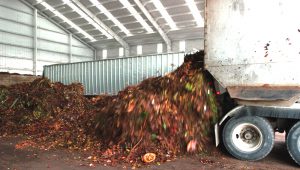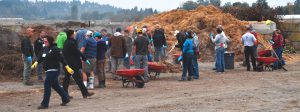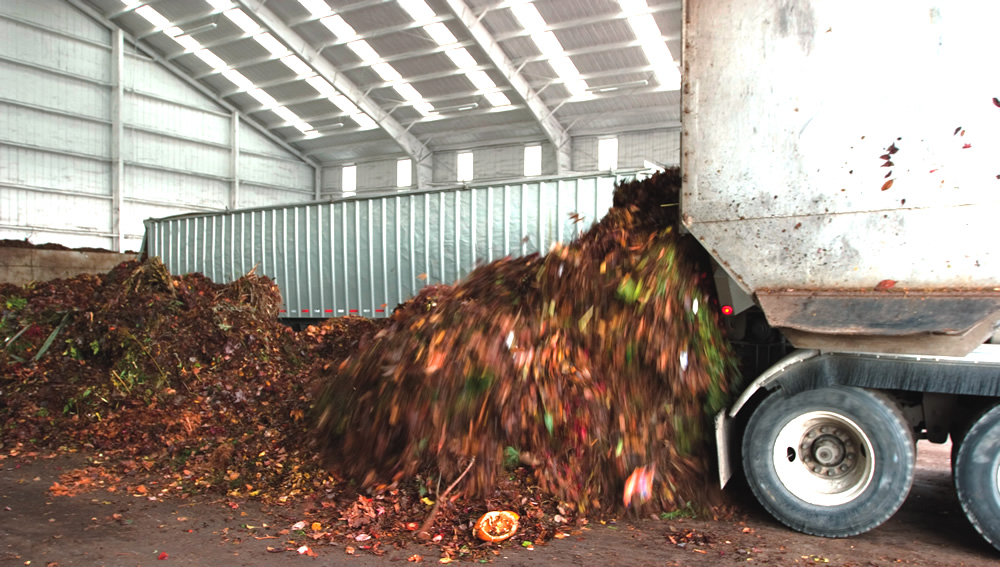The amended rule, which became effective in April 2013, specifically deals with issues seen to hinder development of the composting industry.
Katrina Mendrey
BioCycle October 2013, Vol. 54, No. 10, p. 26

Cedar Grove Composting did not have to make design or operational changes at either of its composting facilities in Washington State to comply with the revised state rule.
Prior to 2003, legal standards regarding composting in the State of Washington were minimal and incorporated into the established solid waste regulations known as WAC 173-304. As recycling of organic waste increased, however, it became clear that a separate rule to address the unique aspects of composting was necessary. At the time, more thorough standards for recycling organics were established under a new rule titled WAC 173-350. And by 2009 that rule was due for an update to “address changes in the ever-evolving organics management process,” explains Mary Harrington, Organics Lead at the Washington State Department of Ecology (Ecology). “The goal of the [most current] rule revisions was to ensure that rules for composting, digestion and other methods of converting organics to energy and/or soil amendments help facilities process materials and produce a product that protects human health and the environment. In turn, good management practices encourage economic vitality for organics-related businesses and communities.”
According to Harrington, Ecology is motivated in achieving these goals by the fact that organics represent over 30 percent of the total solid waste stream in Washington and are the leading cause of greenhouse gas emissions from Washington landfills. The amended rule specifically deals with issues seen to hinder the development of the composting industry — including odor problems and contamination of finished compost — to increase diversion of organic residuals and improve marketability of the final product. In addition, the amended rule broadens exemptions for smaller facilities and includes new and emerging technologies such as anaerobic digesters, some of which were made exempt from solid waste permitting under state statute approved by Washington legislators in 2009. The need to make these revisions was seen to be crucial enough that Ecology moved forward with the update process during a moratorium on rule changes mandated by then Governor Chris Gregoire. (The rule met criteria to allow revisions to go forward.)
Specific changes to the final rule, which officially went into effect in April 2013, were highlighted for stakeholders by Ecology at two public workshops in May 2013. In general, according to Dawn Marie Maurer, workshop facilitator and Solid Waste Facilities Specialist at Ecology, the agency does not anticipate most facilities will need to make any design changes to adhere to the updated rule. Primarily, only operations plans will need to be updated to address changes. So far this seems to be the experience of composters. For example, according to Jerry Bartlett, Chief Environmental and Sustainability Officer at Cedar Grove Composting, Inc. in Seattle, no changes were required to operations or facility design to adhere to the new rule at either of its facilities in King County. The company is permitted to process a total of 423,000 tons of food waste and yard trimmings at the two sites.
Similarly Bill Dean, an Environmental Health Specialist for Thurston County’s Environmental Health department, anticipates minimal additional labor on the part of county jurisdictional health departments (JHD), the regulatory body at the local level that is delegated to enforce Ecology’s composting rule. The JHD employees responsible for regulating compost facilities are trained as sanitarians and often attend the same compost trainings as facility operators. According to Dean, updates will primarily be to 2014 composting permits, which will then serve as templates for subsequent years. Ecology will provide permit review assistance to other health department staff and composting facilities as needed.
Review Of Changes
While there are minimal new requirements for composters and regulators to adhere to in the revised rule, the update did result in considerable changes. For example, previously feedstocks were identified as Types I-IV based on perceived risk to human health and the environment, however, according to Maurer, there was not enough data to support these characterizations. Now feedstocks are specified; for instance, apples from a food processing plant can be assessed by the JHD as food waste or industrial waste depending on the specific circumstances.
Likely a more controversial and important change of terms was the decision to deem finished compost “solid waste” until it has passed “applicable standards for physical contaminants, pollutants, pathogens and other parameters and, it is used on site or distributed off site” (excerpted from an Ecology response to public comments associated with the rule change). If such requirements are not met based on sample testing by composters, the compost must be reprocessed or landfilled. Lab results from these samplings can be requested by regulators and are included in annual reports. Composters, city officials and representatives of recycling organizations voiced concerns via public comments provided in Ecology’s Concise Explanatory Statement, that such a change would hinder the marketability of compost and create liability issues for compost users. However, Ecology defended this change stating that, “Compost facilities are solid waste facilities and the entire site is subject to regulation, including finished materials that may still be decomposing, and may still at some point have an offsite impact… The effect of this change is to ensure that Ecology and jurisdictional health departments can exercise appropriate permitting and enforcement authorities for an entire site.”
Contending With Contaminants
The amended rule also tackles contamination issues seen as a threat to the economic growth of the composting industry. “As solid waste programs continue to sweep up more organics and divert them to composting or anaerobic digestion, the contaminant load increases,” explains Dean. “This makes it more costly for the facility to produce a marketable product.”

The rule includes new training requirements for facility supervisors. The Department of Ecology collaborates with the Washington Organic Recycling Council on compost operator training programs.
The amended rule requires testing of compost for less than one percent physical contaminants by weight. Compost with over one percent physical contaminants or 0.25 percent film plastic by weight must be reprocessed for removal of contaminants. For unrestricted use, compost must contain less than 0.1 percent film plastics. Compost with between 0.1 and 0.25 percent film plastic contamination may be sold but uses are limited and composters must label the finished product as such.
To meet this standard, the rule requires that composters reject loads with greater than 5 percent contamination by volume or have a plan for how to remove contamination before the residual is used as a feedstock. Composters use visual assessments and photographs to help determine if a load is contaminated. In some cases contaminants are removed and weighed to make a more precise assessment of the extent of contamination.
For instance, Cedar Grove has a three-tiered system for managing contaminated loads. Surcharges are added to loads that require additional on-site screening; loads that are too contaminated are rejected. Cedar Grove also rescreens aged compost to further reduce any contamination. “It wasn’t working to just try and educate our customers [about better separation],” notes Bartlett, who contends that additional charges should not be a deterrent from composting the material. “Customers can’t be that angry. They are still getting the economic advantage if they are taking their loads to the composting facility versus the landfill.” Although current language addresses the issue at the facility level, a method Ecology hopes in turn will redirect pressure to collectors, Dean believes the problem still needs to be addressed at the source: “More of an onus should be put on the programs that collect the feedstocks.”
In terms of odor management, the updated rule simply expands on the previous language requiring that operation plans include language regarding how facility managers will handle complaints, prevent odors through good composting practices and handle incoming feedstocks with high moisture and strong odors. “The new rule does not give any prescriptive language regarding odors,” explains Dean. “It has added that the facility’s operations plan must have a progressive odor management plan and our job is to ensure that they have been adhering to that plan when there are substantiated odor complaints.” He adds that the official jurisdictional authority on such matters is the local air agency.
Other changes to the rule include new training requirements for facility supervisors, plans to address prevention of agricultural pest migration, updated sampling requirements and test parameters, as well as changes to how leachate liners will be inspected and requirements for covering aerated static piles. Implementation of the updated rule remains, as before, in the jurisdiction of local health departments for permitted facilities. These regulators will have the authority to enforce all aspects of the rule including interpretation of design requirements allowing for climatic differences between arid eastern Washington and rainy western Washington to be addressed. “For example, all permitted facilities must have lagoon(s) to capture and treat run-off, but the lagoon(s) in low rainfall areas may be smaller than those in high rainfall areas,” notes Harrington. The decision is left to the JHD.
Exempt Facilities
In contrast, exempt facilities are managed by Ecology and are required to notify Ecology and the local health department of their activities, test finished compost for metals and pathogens and submit an annual report to both agencies. Exempt status is restricted by composting method, quantity of processed materials on-site and feedstock type. Under the updated rule, Ecology expects more facilities will operate under exempt status. To qualify, sites can process more than 25 cubic yards (cy) but less than 250 cy of any organic feedstock at any one time. No exempt operation processing postconsumer food waste can exceed this limit and remain exempt. However, facilities processing feedstocks including yard debris, manure and agricultural waste may process larger quantities of materials — up to 1,000 cy in some cases. For example, farms composting greater than 25 cy but not exceeding 1,000 cy of agricultural waste, yard debris and bulking agents on farm at any one time with up to 50 percent of materials represented by yard debris are exempt. Vermicomposters can process any organic feedstock up to 1,000 cy as well.
In the case of anaerobic digesters, facilities may qualify for exemption if they process between 5,000 and 50,000 gallons of any organic feedstock. Once this volume is exceeded, permits must be obtained unless the digester is used to process primarily manure (50% or more) with no more than 30 percent preconsumer nonmanure feedstock. In such cases no volume restrictions apply. Digesters processing postconsumer food waste do not qualify for exemption if they exceed any of these volumes and do not qualify for exemption under the dairy digester rule. Currently there are approximately 10 anaerobic digesters operating in Washington State (not at wastewater treatment facilities); all fall under exempt status as dairy digesters.
Ecology serves as the main point of contact for exempt sites and maintains a database of these facilities. According to Harrington both Ecology and the JHDs “are making efforts to establish better awareness and relationships with the conditionally exempt operations.” Despite their exempt status, these facilities must still adhere to other regulations including those enforced by local air and water authorities as well as local land use and zoning regulations.
The final rule is the product of three years of planning and public involvement, which included participation from composters, haulers, tribes, recycling organizations, consultants and the general public. Ecology conducted several meetings around the state, maintained a list-serve to communicate plan updates and allow for public comment and held public workshops in which over 60 stakeholders, public officials and citizens voiced their opinions on rule changes. “There was a lot more of the general public involved in this process than the previous, which was primarily stakeholders,” says Bartlett comparing the public process in 2003 to the most recent update. Ecology’s efforts to involve the public seem to have paid off. Bartlett and others feel the process and final rule are reflective of input from those involved. “Ecology made a lot of changes to the original draft so many of our concerns went away,” says Bartlett. “In the end they listened.”
Katrina Mendrey recently received her Master’s in Soil Science from the University of Washington.
Rule Highlights
Exemptions: Exempt facilities are managed by the Department of Ecology and required to notify Ecology and the local jurisdictional health department of their activities, test the product for metals and pathogens (with the exception of vermicomposters) and submit an annual report to the agencies, however, they do not need a permit to operate. Any facility processing less than 25 cubic yards is not required to file for exempt status nor report to Ecology or the jurisdictional health department.
Testing: Previous requirements for testing were based on amount of feedstock received. Updated language requires testing based on the amount of compost produced reducing the overall frequency of testing. Representative sampling must now occur every 5,000 cubic yards or once yearly, whichever is most frequent. In addition, composters must test for film plastics as part of physical contaminant testing. Nitrogen testing is also no longer required.
Training: Within one year of operation, facility must be operated by a properly trained individual. This includes a supervisor who must be certified through a training program approved by the jurisdictional health department. Certificate of training must be kept on-site. Other employees depending on job duties must be trained on facility operations, maintenance, safety and emergency procedures, as well as how to identify nuisance odors and correct them.
Agricultural Pest Migration: Operational plan must include strategy for managing migration and spread of agricultural pests, however, facilities are not responsible for spread of pests should incidents occur.
Aerated Static Piles: Operational plan must include use of an insulating cover over aerated static piles.
Inspection of Leachate Liner: Details were added to the rule regarding inspection of leachate liners and expectations for managing repairs to damaged liners.
Odor Management And Prevention: While odor issues were addressed in previous rules, updated language requires additional details be added to operational plans addressing prevention of odor occurrences, how to manage high moisture or poor smelling feedstocks and how to handle odor complaints should they occur.
Capacity and Throughput: Operational plan must include a description of the maximum capacity and throughput of the facility. Capacity is the maximum amount of feedstock a facility could hold at a given moment whereas throughput is the amount of feedstock a facility can process in a given time period, such as a calendar year.










